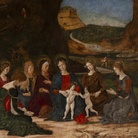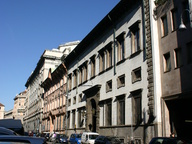Museum

Dainius Liškevičius. A work by an unknown artist. Object, 1970–1980?, photographer Arturas Valiauga, © / courtesy of the artist
Opera di artista ignoto. 1970–1980?
Opera di artista ignoto. 1970–1980?
From 09 Maggio 2015 to 22 Novembre 2015
Venice
Place: Biennale Palazzo Zenobio / Lituanian Pav.
Address: Fondamenta del Soccorso 2569, Dorsoduro
Responsibles: Vytautas Michelkevicius
Official site: http://www.museo.lt
Dainius Liškevičius’ Museum, which has opened in one of Venetian garden s as the Lithuanian national pavilion, is a fictional museum that is based on true and autobiographical facts. The multi - layered collection that has been put together by the artist works as an elliptical time loop. It simultaneously takes us back to the rec ent Soviet past, questions the present, and projects our anxieties on to a future that is full of cultural and geopolitical tensions. Museum is essentially a one - off piece of artistic research, but it is not only relevant in exploring the depths of the Sov iet totalitarian regime. It is also a possible model for dealing with present - day hegemonic powers, and their impact on the public discourse and the freedom of the artist. We can also interpret Museum as a new kind of patriotism, which rethinks the new dem ocracies’ national myths, and their attempts to create legitimacy for a contemporary nation - state. The presentation of Museum as a national pavilion is a transgressive act, which turns it into an institution with greater authority than museums normally have.
The non - hierarchical spatial arrangement of works by the artist, combined with everyday Soviet objects and artefacts, engages the viewer in at least four parallel and overlapping stories. They deal with artistic freedom and freedom of speech in occupied Lithuania, the USSR at large, and the world today.
Within a dense installation (a cabinet of curiosities) created using the language of contemporary art, the viewer is immersed in events of controversial political (?) protest that were initiated in occup ied Lithuania and Leningrad by three ambiguous revolutionary figures during the 1960s – 80s. Dainius Liškevičius rewrites the history of Lithuanian art, proposing that these events be interpreted as cases of underground art, political performance, and art de struction that were prohibited in those times and thus did not exist.
In his vision of Lithuanian (art) history, revamped with subtle irony, the artist offers an unexpected version of the archaeology of objects. Here, every object has both a personal and a collective history that conveys the signs of the times, and allows us to travel in time. Within the space of Museum, Liškevičius’ own life story intertwines with those of dissident revolutionaries and idealised cultural figures (such as Jean - Paul Sartre) , further erasing the thin line between subjective and objective forms of storytelling.
Museum will be guided by Lithuanian - English (and sometimes Italian) speaking guides who will help for the audience to discover intersecting multi - linear narratives in the exposition. The printed English guide will help also to uncover the stories behind the three revolutionary personalities and some of the exhibits. There is also a published book “Museum” (2013) with extended commentaries on the project and full imagery .
The non - hierarchical spatial arrangement of works by the artist, combined with everyday Soviet objects and artefacts, engages the viewer in at least four parallel and overlapping stories. They deal with artistic freedom and freedom of speech in occupied Lithuania, the USSR at large, and the world today.
Within a dense installation (a cabinet of curiosities) created using the language of contemporary art, the viewer is immersed in events of controversial political (?) protest that were initiated in occup ied Lithuania and Leningrad by three ambiguous revolutionary figures during the 1960s – 80s. Dainius Liškevičius rewrites the history of Lithuanian art, proposing that these events be interpreted as cases of underground art, political performance, and art de struction that were prohibited in those times and thus did not exist.
In his vision of Lithuanian (art) history, revamped with subtle irony, the artist offers an unexpected version of the archaeology of objects. Here, every object has both a personal and a collective history that conveys the signs of the times, and allows us to travel in time. Within the space of Museum, Liškevičius’ own life story intertwines with those of dissident revolutionaries and idealised cultural figures (such as Jean - Paul Sartre) , further erasing the thin line between subjective and objective forms of storytelling.
Museum will be guided by Lithuanian - English (and sometimes Italian) speaking guides who will help for the audience to discover intersecting multi - linear narratives in the exposition. The printed English guide will help also to uncover the stories behind the three revolutionary personalities and some of the exhibits. There is also a published book “Museum” (2013) with extended commentaries on the project and full imagery .
SCARICA IL COMUNICATO IN PDF
COMMENTI

-
 Dal 20 dicembre 2024 al 04 maggio 2025
Fermo | Palazzo dei Priori
Dal 20 dicembre 2024 al 04 maggio 2025
Fermo | Palazzo dei Priori
-
 Dal 20 dicembre 2024 al 04 maggio 2024
Gorizia | Palazzo Attems Petzenstein
Dal 20 dicembre 2024 al 04 maggio 2024
Gorizia | Palazzo Attems Petzenstein
-
 Dal 18 dicembre 2024 al 18 dicembre 2024
Venezia | Museo Correr
Dal 18 dicembre 2024 al 18 dicembre 2024
Venezia | Museo Correr
-
 Dal 14 dicembre 2024 al 02 marzo 2025
Palermo | Palazzo Abatellis
Dal 14 dicembre 2024 al 02 marzo 2025
Palermo | Palazzo Abatellis
-
 Dal 12 dicembre 2024 al 23 febbraio 2025
Roma | Palazzo Altemps
Dal 12 dicembre 2024 al 23 febbraio 2025
Roma | Palazzo Altemps
-
 Dal 13 dicembre 2024 al 31 agosto 2025
Roma | Museo dell'Ara Pacis
Dal 13 dicembre 2024 al 31 agosto 2025
Roma | Museo dell'Ara Pacis


